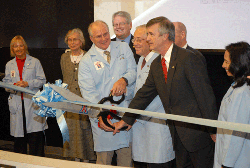
From: Al Bravo, (602) 827-2022 Nov. 19, 2009
 PHOENIX – Arizona is poised to take a national leadership role in development of innovative health-care education strategies and initiatives and save lives by reducing medical errors, thanks to the recent opening of the University of Arizona’s Institute for Advanced Telemedicine and Telehealth (T-Health Institute) at the Phoenix Biomedical Campus.
PHOENIX – Arizona is poised to take a national leadership role in development of innovative health-care education strategies and initiatives and save lives by reducing medical errors, thanks to the recent opening of the University of Arizona’s Institute for Advanced Telemedicine and Telehealth (T-Health Institute) at the Phoenix Biomedical Campus.
As a major new arm of the UA’s award-winning Arizona Telemedicine Program, the T-Health Institute is addressing the need for updated health-care education and new curricula to train “inter-professional” teams of health-care providers, cited as a national goal by the prestigious U.S. National Academy of Sciences’ Institute of Medicine in 2003. Indeed, the T-Health Institute has set a daunting goal to develop a roadmap for the “re-invention” of health-care workforce education in the United States.
“Now is the time to begin a redesign of our health-care education system,” said Ronald S. Weinstein, MD, founding director of the UA’s internationally noted Arizona Telemedicine Program. “Many national leaders are getting on board for this much-needed overhaul and the T-Health Institute is well-positioned to play a leadership role.”
For the past century, health-care workers have been educated in profession-specific “silos,” and communication among students in medical schools, nursing schools, pharmacy schools and the allied health professional schools often is very limited. Coordination of training in the various health professions is uncommon at most U.S. universities, he said.
An official dedication for the first-of-its-kind facility recently took place at the University of Arizona College of Medicine – Phoenix in partnership with Arizona State University in downtown Phoenix. The event showcased the T-Health Amphitheater, a state-of-the-art videoconferencing facility and a key component of the institute.
“This remarkable amphitheater is the result of years of research, planning and implementation,” said Dr. Weinstein. “We’re so pleased this facility now is completed so we can begin our efforts.”
Retro-fitted into the third floor of the century-old Phoenix Union High School Auditorium, the T-Health Institute’s federal- and state-funded amphitheater is loaded with highly innovative, custom designed social-networking platforms.
“These first-of-a-kind video-conferencing platforms will enable the development and implementation of the next generation, inter-professional curricula required to address how best to educate teams of doctors, nurses, pharmacists and allied health professionals,” Dr. Weinstein said.
The amphitheater already is one of three urban hubs of the Arizona Telemedicine Program’s vast statewide “virtual campus” that stretches throughout Arizona. Its unique broadband telecommunications network already is an invaluable asset for the state’s health-care delivery and education efforts. The amphitheater is linked to 71 rural and urban communities.
On- or off-campus health-care students from all disciplines and faculty members working at dozens of sites hundreds of miles away can be assembled electronically on the amphitheater’s large, 12-screen video wall. The system has shattered traditional time-space barriers through the development and implementation of advanced videoconferencing techniques, developed by Dr. Weinstein and Richard A. McNeely, director of Biomedical Communications at the UA’s Arizona Health Sciences Center.
The T-Health Institute also is focused on a more immediate challenge: to help reduce deaths due to medical errors, one of the five leading causes of death in adults in the United States. The Institute of Medicine attributes more than 100,000 deaths per year nationally to medical errors, and inter-disciplinary communication barriers are believed to be a major factor adversely affecting patient care.
“Unfortunately, a significant number of these deaths can be related to miscommunication among various health-care professionals -- physicians, nurses and pharmacists,” Dr. Weinstein said. “As a practicing pathologist, I am very aware of the fragmentation of health-care in the United States. We are deeply concerned about inter-professional communications issues.”
Federal funding for the construction of the T-Health Institute was sponsored by U.S. Sen. Jon Kyl, R-Ariz., and U.S. Rep. Ed Pastor, D-Ariz., both of whom taped congratulatory remarks for the T-Health dedication luncheon. The T-Health facilities received the 2008 ComputerWorld 21st Century Award for innovation in the Education and Academia category. The U.S. Department of Health and Human Services recently funded the T-Health Institute, and its parent organization, the Arizona Telemedicine Program, to serve as the Southwest Regional Telehealth Resource Center, providing training and technical assistance in telehealth and electronic health record implementation for health-care professionals.
# # #
Photo caption: Ribbon-cutting ceremony in the T-Health Amphitheater on the Phoenix Biomedical Campus. From left: Anna R. Graham, MD, UA professor emeritus of pathology and scholar-in-residence at the Arizona Telemedicine Program; Madeline Schmidt, PhD, RN, professor emeritus of nursing, University of Rochester and national leader in inter-professional health-care education; State Senate President Robert “Bob” Burns, chair of the Arizona Telemedicine Council and co-founder of the Arizona Telemedicine Program (Senator Burns is wearing his own Arizona Telemedicine Program lab coat); Jon Linkous, executive director of the American Telemedicine Association, Washington, D.C. ; Ronald S. Weinstein, MD, founding director of the Arizona Telemedicine Program; UA President Robert N. Shelton; J. Lyle Bootman, PhD, dean, UA College of Pharmacy and member of the Institute of Medicine; and Aná Mariá Lopez, MD, medical director, Arizona Telemedicine Program, associate dean for outreach and minority affairs, UA College of Medicine.
About medical curriculum
Current medical school curriculum in the United States, consisting of four years of undergraduate college education followed by another four years of medical school, became the standard format for medical education after the publication of the influential “Flexner Report” in 1910. This was just before the time of the construction of the Auditorium Building of the Phoenix Union High School. Ironically, Abraham Flexner, who authored his legendary report, “Medical Education in the United States and Canada,” actually was a high school teacher for many years prior to his authoring the influential report.”